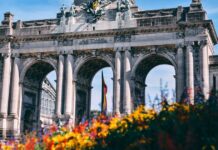What’s really behind Donald Trump’s tariff threats and ’51st state’ posts about Canada
Donald Trump’s threat of whopping tariffs on Canadian exports and his trolling of Prime Minister Justin Trudeau are key tactics in a negotiating strategy to extract the best trade terms for the U.S., according to people who have worked with or closely observed him over the years.
Trump is promising to slap a 25 per cent tariff on all goods entering the U.S. from Canada and Mexico on Jan. 20, his first day in office, unless the countries curb the flow of drugs and migrants across their borders.
The president-elect has since followed up that threat by taunting Trudeau by calling him “governor” and referring to Canada as the “51st state” in a succession of social media posts.
Analysts say this approach echoes the trademark negotiating style that Trump has employed for many years, both in business and the presidency.
Stephen Moore, who served as an economic adviser to Trump during his first term in the White House, says the president-elect is aiming to get leverage in renegotiating the three-way trade agreement between the U.S., Canada and Mexico.
“I think there’s no question that that’s what he’s doing here,” Moore said in an interview with CBC News.

“I’ve seen Trump up-front and personal over his presidency and I’ve talked to him quite a bit about this,” said Moore, now a senior economist at the conservative Heritage Foundation.
“He uses the threat of tariffs to get countries to do things that he thinks are in America’s national security and economic interests.”
Strategy ‘worked out pretty well’ in 1st term
Although Moore is no fan of tariffs from the perspective of their impact on the economy, he understands why Trump is threatening to impose them on Canada and Mexico.
“He wants to make sure that the trade deals that we have are fair for American workers and American companies,” he said. “That’s been a strategy that worked out pretty well in the first term, and I hope it will in the second term as well.”
Trump used the one-two punch of tariffs and taunts against Canada in 2018 during the talks that led to the Canada-U.S.-Mexico Agreement (CUSMA). He slapped tariffs on steel and aluminum, threatened tariffs on auto exports and called Trudeau “very dishonest and weak.”
Eugene B. Kogan, who teaches advanced negotiation skills at Harvard and has written about Trump’s negotiating style, says the president-elect has long used the tactic of denigrating his competition as a way of gaining leverage.

“Prime Minister Trudeau is in political trouble at home, and I think that president-elect Trump is sensing the weakness,” said Kogan in an interview with CBC News. “He smells blood.”
He says that Trump “is an incredibly rational, brutally ruthless analyst of human weakness and political weakness, and that is when he senses most of his leverage.”
He believes Trump thinks “on an almost 24-hour basis” about how to exploit an opponent’s vulnerabilities and turn them into opportunities for gain.
Launching a threat of stiff tariffs against such a longstanding trading partner even before taking office is emblematic of what Kogan describes as Trump’s “win-lose” approach to negotiations.
Power move to establish leverage
“He is making a power move driven by the desire to establish his leverage,” Kogan said. “The underlying message is, ‘I will make it unpredictable for the other side, so much that the other side will be under pressure to make concessions.’ ”
Trump’s transition team did not respond to a request for comment.

There are a range of observers from Wall Street to Bay Street to Congress who view Trump’s tariff salvo against Canada and Mexico as a means of gaining leverage in talks on the three-way trade deal, which comes up for renewal in 2026.
-
“This latest tariff threat effectively marks the start of negotiations,” said international wealth management firm UBS Global in a recent briefing note.
-
“Trump’s best and most likely use of tariffs are as a bargaining chip to force Canada into concessions” when CUSMA is renegotiated, wrote TD economist Marc Ercolao.
-
“Right now, I see everything that Trump’s doing on tariffs as a negotiating tool,” said Iowa Republican Sen. Chuck Grassley, according to Politico.
Trump’s pick for treasury secretary, Scott Bessent, praised the president-elect for using tariffs as “a negotiating tool with our trading partners,” in an opinion piece published on the Fox News website shortly after the election.
Marc Thiessen, a chief speechwriter for former U.S. president George W. Bush and a fellow at the American Enterprise Institute, said last week that Trump is both serious about imposing tariffs on Canada and about using them to negotiate.
“If they don’t come around and do what he wants them to do, then he will slap those tariffs on them,” Thiessen told Fox News. “I think he also knows that Justin Trudeau is incredibly weak.”
U.S. president-elect Donald Trump claimed on social media that he urged hockey icon Wayne Gretzky to run for prime minister during a Christmas visit. It’s Trump’s latest comment on Canadian politics, following quips about Canada becoming the U.S.’s 51st state and meeting ‘Governor’ Justin Trudeau.
On Christmas Day, Trump posted that he’d urged Wayne Gretzky to “run for Prime Minister of Canada” and that the hockey legend “would win easily.” He has also mused about buying Greenland and taking control of the Panama canal.
Trump’s comments about Canada, Mexico, Greenland and Panama are tied together by the common thread of countering Russia and China, an unnamed transition official told the Washington Post.
“This isn’t just slapdash, there’s a coherent connective tissue to all of this,” the Post quoted the official as saying. “Trump knows what levers to pull.”
Even if there’s consensus that Trump’s tactics when it comes to Canada are designed to gain leverage, a big question that remains unanswered is what his end goal could be.
Many doubt that a crackdown on fentanyl trafficking and illegal migration — Trump’s stated reasons behind the tariff threat — is all he wants.
That view was given some credence on Friday when two Trudeau cabinet ministers met two of Trump’s cabinet picks in Florida to brief them on Canada’s plan for improving border security.
Foreign Affairs Minister Mélanie Joly and Finance Minister Dominic LeBlanc travelled to Florida on Friday to discuss potential tariffs with representatives of the incoming Trump administration.
A senior Canadian government source told CBC’s Katie Simpson that Trump’s fixation with the U.S. trade deficit with Canada came up at the meeting.
Trump has repeatedly — and inaccurately — characterized the trade imbalance as the U.S. subsidizing Canada.
Crude oil imports drive U.S. trade deficit
The trade deficit, which ran about $75 billion US in 2023, is largely the result of Canada’s record-high crude oil exports to its southern neighbour.
The U.S. imported more petroleum from Canada last year than from all other countries combined, according to statistics from the U.S. Energy Information Administration.
Moore says he thinks Trump’s objective is to make North America “geopolitically the most important region in the world when it comes to energy.”
In his 1987 book The Art of the Deal, Trump wrote, “Leverage: don’t make deals without it.” There’s plenty of evidence that nearly 40 years later he is still following that maxim.
Published at Sun, 01 Dec 2024 09:01:00 +0000
New Year’s celebrations around the world ring in 2025
From Sydney to Vladivostok to Mumbai and St. John’s, communities around the world welcomed 2025 with spectacular light shows, embraces and other ways to say goodbye to 2024.
A fireworks display over Quidi Vidi Lake in St. John’s, N.L., helped usher in the new year in Canada.
In Auckland, the first major city to celebrate, thousands took to the downtown area or climbed the city’s ring of volcanic peaks for a fireworks vantage point. A light display recognized Indigenous people.
Countries in the South Pacific Ocean were the first to ring in 2025, with midnight in New Zealand striking 18 hours before the ball drop in Times Square in New York City.
Conflict muted marking the new year in places like the Middle East, Sudan and Ukraine.
Fireworks blasted off the Sydney Harbour Bridge and across the bay. More than a million Australians and others gathered at iconic Sydney Harbour for the celebration. British pop star Robbie Williams led a singalong with the crowd.
The celebration also featured Indigenous ceremonies and performances.
Communities in New Zealand, Australia and Hong Kong were among the first in the world to ring in 2025, and they did so in style with the help of music, lasers and fireworks.
Toronto was set to feature a 10-minute waterfront fireworks display and a series of pop-up performances. In previous years, about 250,000 people attended the display at the waterfront.
Asia gets ready for the Year of the Snake
Much of Japan shut down ahead of the nation’s biggest holiday, as temples and homes underwent a thorough cleaning.
The Year of the Snake in the Asian zodiac in 2025 is heralded as one of rebirth — alluding to the reptile’s shedding skin.
Stores in Japan, which observes the zodiac cycle from Jan. 1, have been selling snake-themed products. Other places in Asia will mark the Year of the Snake later with the Lunar New Year.
In South Korea, celebrations were cut back or cancelled during a period of national mourning following the Sunday crash of a Jeju Air flight at Muan that killed 179 people.
In Bangkok, shopping malls competed for crowds with live musical acts and fireworks shows. A fireworks display in Jakarta featured 800 drones.
West’s rivals exchange goodwill
Chinese state media covered an exchange of 2025 greetings between Xi Jinping and Russian President Vladimir Putin in a reminder of growing closeness between two leaders who face tensions with the West.

Xi told Putin their countries will “always move forward hand in hand,” the official Xinhua News Agency said Tuesday.
China has maintained ties and robust trade with Russia since the latter invaded Ukraine in 2022, helping to offset Western sanctions and attempts to isolate Putin.

In India, thousands of revellers in the financial hub of Mumbai flocked to the bustling promenade facing the Arabian Sea. In Sri Lanka, people gathered at Buddhist temples to light oil lamps and incense sticks and pray.
In Dubai, thousands attended a fireworks show at the Burj Khalifa, the world’s tallest skyscraper. In Nairobi, scattered fireworks were heard as midnight approached.
Conflicts cast shadow in the Middle East
Celebrations were expected to be subdued in Israel and Gaza, where the war with Hamas grinds through a 15th month, with tens of thousands of people killed and scores of hostages remaining in captivity.
Dubai welcomed the new year with fireworks over the iconic Burj Khalifa, while Bangkok’s fireworks crafted from sticky rice lit up the sky in pastel and gold hues. In Damascus, people gathered at a Christmas market to ring in 2025, some waving Syrian flags and recording the fireworks display on their phones.
Lebanon is in the grip of a severe economic crisis, and many areas were heavily damaged during the war between Israel and Hezbollah. Meanwhile, Syrians have expressed hope and uncertainty for the coming year after the overthrow of Bashar al-Assad as president.
A holy year begins
Rome’s traditional New Year’s Eve festivities had an additional draw: the start of Pope Francis’s Holy Year, the once-every-quarter-century celebration projected to bring some 32 million pilgrims to the Eternal City in 2025.
On Tuesday, Francis was set to celebrate a vespers at St. Peter’s Basilica, followed by mass on Wednesday, when he is expected to once again appeal for peace amid wars raging in Ukraine and the Middle East.

Hours before Germany rang in the new year, Chancellor Olaf Scholz called on its 84 million residents to stick together despite global crises and wars, the country’s ailing economy and a deadly Christmas market attack that shocked the nation.
“We are a country of togetherness and we can draw strength from this — especially in difficult times like these,” Scholz said in his prerecorded speech.
Paris caps year with celebration at Champs-Elysées
Paris capped a momentous 2024 with its traditional countdown and fireworks extravaganza on the Champs-Elysées. The city’s emblematic Arc de Triomphe monument was turned into a giant tableau for a light show that celebrated the city’s landmarks and the passage of time with whirring clocks.
Parisians lined the famous Champs-Élysées avenue to celebrate the new year with musical performances, light shows and a fireworks display. In Berlin, revellers welcomed 2025 at the Brandenburg Gate, while London hosted a fireworks display over the River Thames as Big Ben struck midnight.
The Summer Olympics and Paralympic Games hosted in the French capital from July to September had transformed the city into a site of joy, fraternity and astonishing sporting achievements
London rang in the New Year with a pyrotechnic display along the River Thames. With a storm bringing bitter weather to other parts of the United Kingdom, however, festivities in Edinburgh, Scotland, were cancelled.
2 million revellers
Rio de Janeiro was throwing Brazil’s main New Year’s Eve bash on Copacabana Beach, with barges shooting off 12 straight minutes of fireworks. Thousands of tourists in cruise ships and charter boats were dropping anchor to witness the show up close, while many were streaming onto the sand to find their spot. More than 2 million people — most decked out in white to keep with tradition — were expected on Copacabana

American traditions old and new
In New York City, the organization managing Times Square tested its famous ball drop and inspected 2025 numerals, lights and thousands of crystals, as part of a tradition going back to 1907. Musical performances by TLC, Jonas Brothers, Rita Ora and Sophie Ellis-Bextor were scheduled for this year’s celebration.
The party, covering multiple blocks around the city’s main tourism and theatre hub, was expected to draw large crowds despite rain and chilly weather.

Las Vegas was set to bid farewell to 2024 with old — and some new — traditions. Its annual eight-minute pyrotechnic show will be on in the Las Vegas Strip, with 340,000 people anticipated as fireworks are launched from the rooftops of nine casinos.
Nearby, the massive Sphere venue was to display for the first time countdowns to midnight in different time zones.
Published at Tue, 31 Dec 2024 13:07:07 +0000












